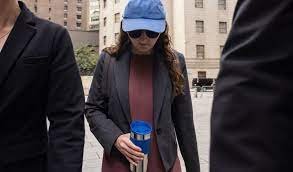On Thursday, Judge Lewis Kaplan sentenced FTX founder Sam Bankman-Fried to 25 years in jail, citing testimony from Caroline Ellison, the defendant’s ex-girlfriend and an early recruit into his crypto firm.
“I keep coming back to Ms. Ellison’s testimony that he knew it was wrong,” Kaplan stated at the sentencing hearing in downtown Manhattan. “He knew it was criminal.”
Ellison was the key witness in the Department of Justice’s prosecution against Bankman-Fried. She consented to a plea deal in December 2022, a month after FTX declared bankruptcy.
Ellison provided the government and the jury with text messages, papers, and secret recordings during her evidence at the criminal trial late last year, which ultimately contributed to Bankman-Fried’s conviction on all seven charges.
Manhattan U.S. Attorney Damian Williams said in a statement following the sentencing on Thursday that Bankman-Fried’s “deliberate and ongoing lies demonstrated a brazen disregard for his customers’ expectations and disrespect for the rule of law, all so that he could secretly use his customers’ money to expand his own power and influence.”
Ellison, who oversaw FTX’s sibling hedge fund Alameda Research, pleaded guilty to two counts of wire fraud, two counts of conspiracy to commit wire fraud, conspiracy to commit commodities fraud, conspiracy to commit securities fraud, and conspiracy to commit money laundering.
Ellison faces similar sentencing standards as Bankman-Fried, but she is expected to receive a far less sentence because of her position as a cooperating witness.
Ellison’s tangled ties with SBF
Ellison joined Bankman-Fried’s cryptocurrency orbit in 2017.
She had been working as a trader at Jane Street, where Bankman-Fried began his career in finance. Bankman-Fried reportedly persuaded the Stanford graduate to leave her Wall Street job and join Alameda while the hedge fund was still in its original Bay Area location.
Ellison spent years as Bankman-Fried’s on-and-off girlfriend and, at times, housemate. She followed Bankman-Fried from California to Hong Kong and, eventually, the Bahamas, as his crypto businesses’ offices changed frequently.
Michael Lewis wrote about Ellison in his book “Going Infinite,” which also examined Bankman-Fried’s ascent and fall. Ellison was promoted to CEO of Alameda in 2021, a position for which neither Ellison nor Bankman-Fried thought she was particularly qualified, according to Lewis’ account.
“Caroline sensed that, even as Sam promoted her to CEO of Alameda Research, he disapproved of her job performance — and she shared his opinion,” Lewis wrote in a letter.
Lewis shared an excerpt from one of the memoranda Ellison had sent to Bankman-Fried. “It feels like I’m doing a much worse job managing Alameda than you would if you were working on it full-time,” she wrote in an email.
In April 2021, Ellison tweeted about “regular amphetamine use” in a thread that also discussed the “herculean” effort it took her to get off the sofa and go for a hike.
According to court records, Ellison’s remuneration was low in compared to other top executives. Of the $3.2 billion paid to the exchange’s founders and other senior personnel, FTX’s head of engineering, Nishad Singh, received $587 million, co-founder Gary Wang received $246 million, and Bankman-Fried received $2.2 billion. Ellison got $6 million.
Bankman-Fried disclosed some of Ellison’s private diary writings to The New York Times, which reported on them in July of last year, months before the trial. Bankman-Fried ended up back in jail after Kaplan revoked his bail for alleged witness tampering.
In a Google document published with the Times in February 2022, Ellison wrote, “I’ve been feeling quite miserable and stressed with my job. At the end of the day, I can’t wait to get home, turn off my phone, have a drink, and escape from it all.”
She went on to say, “It doesn’t really feel like there’s an end in sight.”
‘Trying to fix problems.‘
However, jurors first heard Ellison speak in court.
During the trial, US Attorney Thane Rehn stated that Bankman-Fried “was using her as a front” while “in reality, he was still calling the shots at Alameda.” During her multi-day testimony, Ellison helped prosecutors develop a narrative that she was operating at the instruction of Bankman-Fried in assisting him in stealing client money from FTX and using it to help prop up Alameda, which was suffering as a result of the crypto winter.
According to Ellison, Bankman-Fried was still CEO of Alameda when the money funneling occurred. She stated that she assumed it was FTX client money because the amounts exceeded the exchange’s profits and capital raised.
Ellison testified that FTX utilized $1 billion in client funds to repurchase shares in the company from competitor exchange and early investor Binance in mid-2021.
Ellison stated she pondered leaving Alameda many times between 2019 and November 2022.
Ellison had a section on one of her Google Docs titled “limiting factors in scaling,” which she said related to items that were impeding Alameda’s growth. The first thing she mentioned was management, including a remark about her former co-CEO, Sam Trabucco.
“I feel like neither Trabucco nor I has been doing a great job of pushing on stuff,” she stated in an email. “We’re in the mode of maintaining status quo and trying to fix problems.”
Regarding the commingling of operations between FTX and Alameda, Ellison confessed on the witness stand that the two companies lacked an appropriate “Chinese wall” separating them.
Ellison avoided eye contact with Bankman-Fried throughout her testimony, glancing down at her hands between questioning and frequently tossing her hair over her left shoulder. Bankman-Fried frequently turned aside, hands clinched.
Ellison told the jury that her breakup with Bankman-Fried in the spring of 2022 had an impact on their conversations. Despite the fact that they shared an apartment, they generally spoke via Signal and avoided each other outside of work.
Danielle Sassoon, the assistant US attorney representing the government, told Kaplan several times that “the defendant has laughed, visibly shaken his head, and scoffed,” which she said could be having an effect on Ellison “given the history of this relationship, the prior attempts to intimidate her, the power dynamic, and their romantic relationship.”
Secret recordings and texts.
Among the hundreds of items presented as evidence during the trial, a bank of messages on the encrypted app Signal was among the most disastrous for Bankman-Fried.
The government displayed a series of Signal communications between Bankman-Fried, Ellison, Wang, and other prominent executives. In one such conversation, dated November 8, 2022, Ellison asked Bankman-Fried and other members of the inner circle for advice on optics and public message.
She said, “Several people internally have asked me if they should continue to make representations to external parties such as ‘Alameda is solvent.’ Should I propose they stall instead? simply stall in responding to their messages? “Or what?”
That day, FTX halted all customer withdrawals.
The next day, Ellison returned to the group for advice on how to conduct an all-hands meeting for Alameda’s about 30 employees.
Ellison’s plan was to inform them that “Alameda is probably going to wind down” and that there was “no pressure” to stay, but assistance with “stuff like making sure our lenders get paid” would be “super appreciated.”
Bankman-Fried advised she mention something about there “being a future of some sort for those who are excited.”
Ellison ended up disclosing far more than that during the staff meeting, which was secretly recorded and played for the jury.
“Alameda borrowed a bunch of money,” which it used to make investments, Ellison remarked at the conference. But as crypto values declined, “FTX had a shortfall of user funds,” and then “users started withdrawing their funds” and “realized they would not be able to continue.”
When a staffer questioned her who came up with the idea to cover Alameda’s loan losses with FTX client money, she laughed and answered, “Um, Sam, I guess.”
“FTX basically always allowed Alameda to, like, borrow user funds, as far as I know,” Ellison went on to say.

